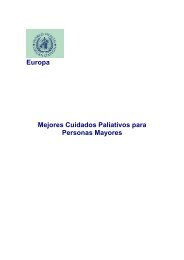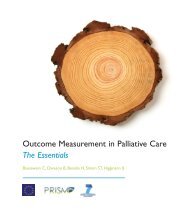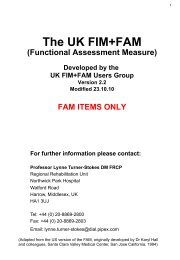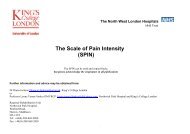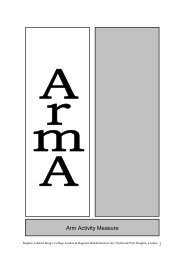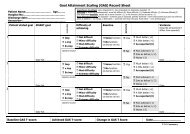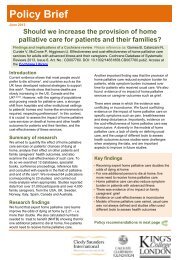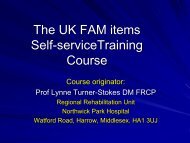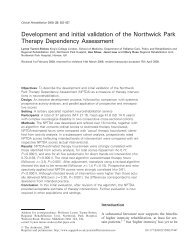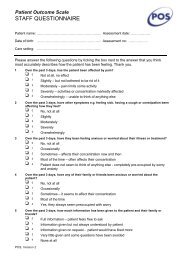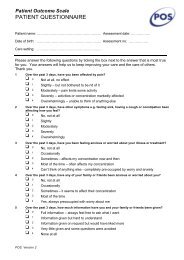The Rehabilitation Complexity Scale - King's College London
The Rehabilitation Complexity Scale - King's College London
The Rehabilitation Complexity Scale - King's College London
- No tags were found...
Create successful ePaper yourself
Turn your PDF publications into a flip-book with our unique Google optimized e-Paper software.
Lynne Turner-Stokes, Rebecca Disler and Heather WilliamsTable 2. Analysis of distinguishing features of a complex specialised (CS) rehabilitation service.DS CSservices servicesService characteristics (%) (%) χ 2 p valueStaffingConsultant in rehabilitation 100 100 NA 1.0medicineConsultant in neuro- 62 79 1.35 0.24psychiatry/neuropsychology<strong>Rehabilitation</strong>-trained nurses 85 90 0.24 0.62AHPs at clinical specialist/ 37 70 5.00 0.02consultant gradeWorking practice and staff developmentMD case notes 81 90 0.66 0.41MD ward round/treatment 100 100 NA 1.0planningMD goal setting 100 100 NA 1.0MD outcome evaluation 77 75 0.50 0.82Specialist staff training offered 59 85 3.64 0.06Specialist registrar training 59 65 0.16 0.70programmeActive research >4 papers 11 25 1.57 0.26per yearRegular presentation at 33 70 6.18 0.01rehabilitation conferencesCaseloadMore than a third of caseload 74 90 1.88 0.26need ≥2 for most care tasksTake patients requiring 74 70 0.95 0.76one-to-one special nursingTake patients with tracheostomy 63 80 1.59 0.21Able to manage patients with 37 40 0.04 0.84aggressive behaviour>a third of caseload require 82 90 3.03 0.22MD input from >3 disciplines>a third of caseload require 63 80 1.59 0.21intensive input >4 hoursper daySpecial facilitiesLight workshop 26 45 2.39 0.30Heavy workshop 11 20 0.90 0.64Music therapy 7 0 1.62 0.44Art therapy 15 20 0.43 0.81Hydrotherapy 37 75 7.74 0.02Harness-treadmill training 26 55 4.75 0.09Custom-made splints/orthotics 85 95 1.30 0.52Patient computer facilities 66 90 6.4 0.04DS CSservices servicesService characteristics (%) (%) χ 2 p valueSpecial facilities – continuedElectro-assistive technology 55 70 2.56 0.28(eg environmental controlsystems)Special seating and wheelchair 66 85 4.70 0.09systems providedAssessment and demonstration 18 16 0.27 0.87of communication aidsSpecialist programmes of treatment offeredInpatient complex rehabilitation 81 90 0.84 0.66assessmentComa-arousal programme 15 20 4.63 0.10Specialist spasticity management 96 90 0.84 0.65Tracheopharyngeal 26 70 10.20 0.006managementGroup therapy programmes 48 55 1.23 0.54Cognitive/behavioural 51 70 2.99 0.22rehabilitation programmeTreatment under sections ofthe Mental Health Act 1983 18 5 2.07 0.36Sexual counselling 26 35 0.88 0.64Formal family support and 30 60 5.62 0.06counsellingComplex discharge planning 85 95 1.30 0.52Back to work programmes 30 55 3.76 0.15Medical support and facilitiesCT imaging 84 95 1.40 0.49MRI 84 95 1.40 0.49MRA 65 75 0.93 0.63Doppler vascular studies 85 85 0.18 0.91EMG 73 90 5.71 0.06EEG 73 80 3.26 0.1924-hour medical cover 78 85 0.63 0.7324-hour consultant on call 74 95 3.82 0.15Able to manage patients with 52 70 2.25 0.32acute intercurrent illnessNerve blocks 40 70 5.05 0.08Botulinum toxin injections 88 95 0.35 0.84Perendoscopic gastrostomy 78 80 3.03 0.86insertion/removalTendon release procedures 51 55 0.91 0.63Suprapubic catheter insertion 65 75 0.93 0.54Intrathecal pump insertion and 38 50 0.89 0.64maintenancePressure sore grafting 38 45 0.89 0.64AHPs = allied health professionals; CT = computed tomography; DS = district specialist; EEG = electroencephalography; EMG = electromyography;MD = multidisciplinary; MRA = magnetic resonance angiography; MRI = magnetic resonance imaging; NA = not applicable.596 Clinical Medicine Vol 7 No 6 December 2007




